The Restigouche – Three Days of Paddling this Famous River
The Restigouche is one of Atlantic Canada’s fabled salmon rivers. At the right time of year a long section of the river from the confluence of the Kedgwick to the mouth of the Upsalquitch is virtually a deserted wilderness. It’s usually easy paddling, with no portages and only the occasional stretch of very mild white water. There are well maintained campsites with outdoor privies, picnic tables and at one, a covered shelter. Best of all there is an outfitter conveniently located right at the starting point of the trip who can provide everything you need for the journey, except clothes and sleeping bag, for a very reasonable price. Read on and I’ll tell you how to do this trip on your own or with a larger group.
The first thing to do is check out the internet. The section of the Restigouche you’ll be traveling has been designated a Canadian Heritage River and you can learn a lot about the river’s history and ecology by visiting the site. Next visit the Canoe Restigouche site and check out the packages that Roland and Andre Arpin offer – their service is excellent and prices very reasonable. They’ll provide you with large flat bottomed Old Town canoes (perfect for this type of river), life vests, tents, all cooking supplies, wonderful food and plenty of things you would probably forget if planning the trip on your own. Probably the best thing included in the price is that your vehicle will be driven from the departure site at Kedgwick River to the de-embarkation site at The Landing, a considerable distance away by road. This service makes the logistics of this trip much more doable than if you had to park one vehicle at one end and a second at the other.
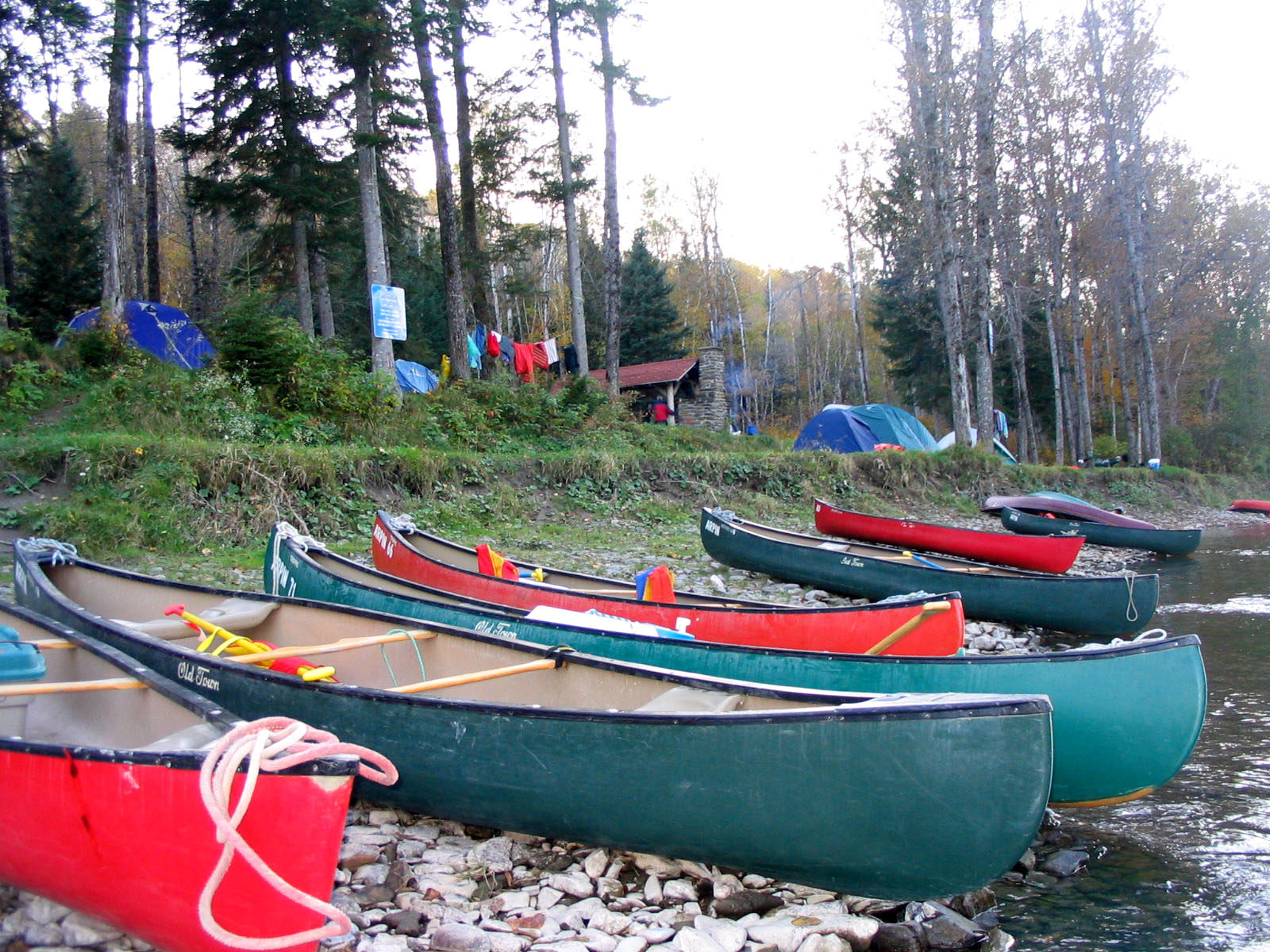
You bring clothes, sleeping bag and thermarest, and of course your own selected refreshments. Also useful are a small saw for cutting driftwood for the nightly fire, a headlamp (better than a flashlight), a lighter or wooden matches and maybe a guitar if anyone thinks they can sing.
One more very useful object is a detailed map of the river which shows every camp, riffle, pool, island or other feature. The New Brunswick Department of Tourism has produced an excellent map of the Restigouche which can be purchased from the Arpin’s for $10. It makes running the river the first time a lot more comfortable when you know what’s coming up. Also make sure you put everything in a waterproof bag, of which there are many good makes and models, available at reasonable prices.
Next, decide when to go on your adventure on the Restigouche. If your schedule is flexible this is really a no brainer – the first few days after salmon fishing season ends, usually around October 1st, should be perfect. The fishermen have deserted the river leaving their camps to solitary riparians, there are next to no bugs, there’s plenty of wildlife and the autumn colours are at their peak. You may have the river to yourself except for a few guides who regularly patrol to check out the salmon pools. If you can’t do this trip in October ask the Arpin’s for their recommendation as water levels fluctuate quite rapidly from May through September and often it can be too low to accommodate even canoes in mid-summer.
Getting to Kedgwick River and the Arpin’s shouldn’t pose a problem for any but the most directionally challenged. It’s about a one hour drive from Campbellton to the town of Kedgwick on well-marked roads and another ten minutes to the Arpin’s. Campbellton is a 5-6 hour drive from Halifax so if you’re coming from Nova Scotia it’s probably wise to stay the night in Campbellton.
The year we went there was a party of twenty three who made the journey. They ranged in age from 18 to late 60’s and included all levels of ability from genuine experts who had traversed some of Canada’s toughest whitewater to a German girl who claimed this was the first time in her life that she had been outside a city.
Alison and I, always anxious not to be late, arrived at Arpin’s well before anyone else. Being the first to arrive had its negative aspects. After signing the usual waivers and paying, I volunteered to move the approximately forty cartons, containers and coolers of stuff down to the riverbank. Even after this was done the only other group that had arrived were three regulars, two Gregs and a John, who had started out from Halifax sometime very early in the morning. After having waited to go on this trip for years (something always came up), we couldn’t wait any longer. The weather was unseasonably warm at twenty degrees Celsius, the skies were blue and the river beckoned.
The previous night I had asked Alan, the group leader, where we would establish camp after the first day’s canoeing and with the map was confident we could find it without any problem. After loading the canoe with our gear, grabbing a communal watertight bag labeled “tents”, some small coolers and a larger one intriguingly labeled “snacks” Alison got in front and with a gentle shove I jumped in and we were off to the Restigouche.
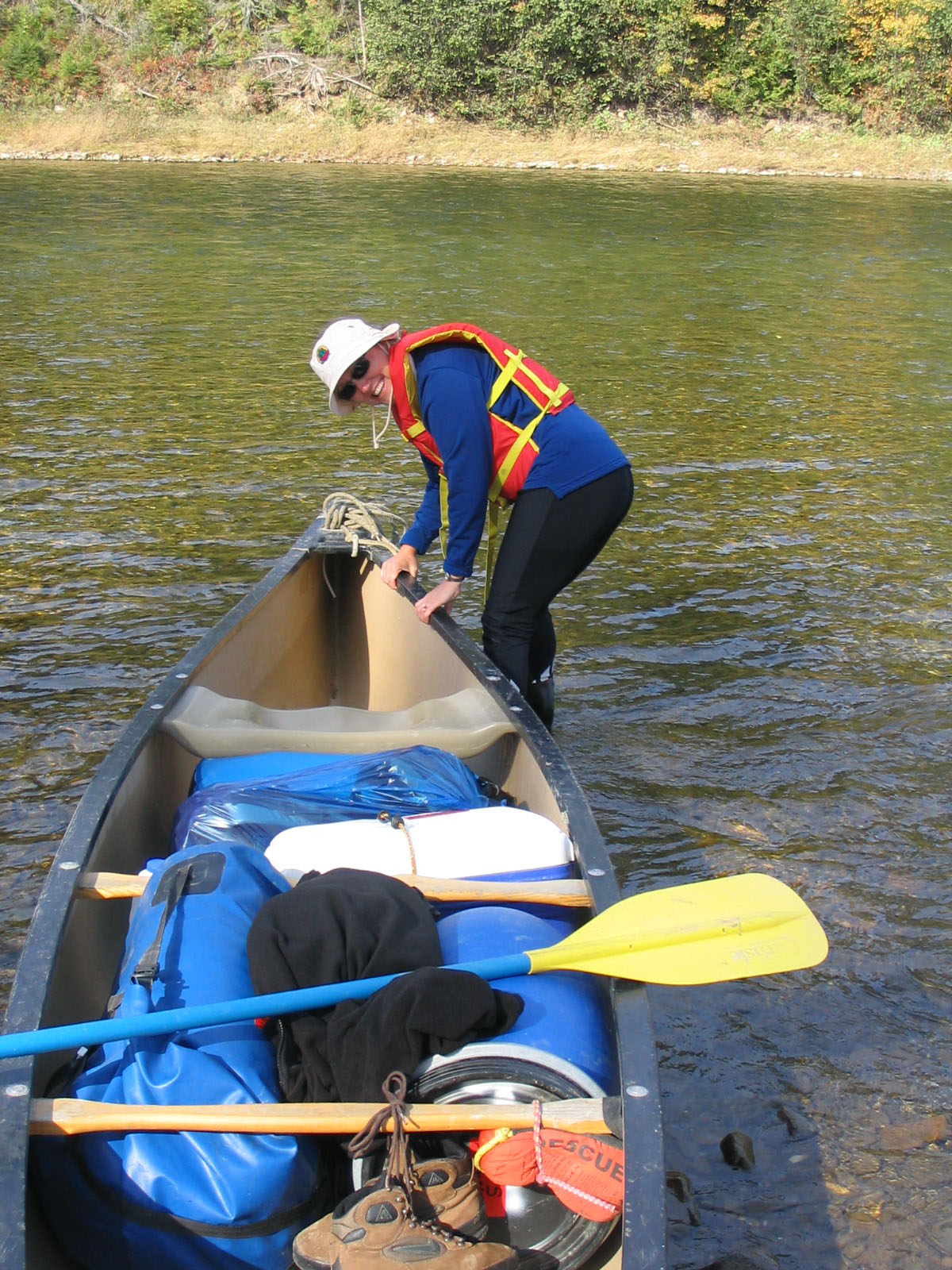
The waters of the Restigouche are fast flowing, wide and clear, really clear, with a clarity you only imagine in your dreams of great canoeing trips. Within a hundred yards of the departure point the Kedgwick River emptied its vigorous flow into the Restigouche producing a pool where at least a dozen grilse (3-8 lb.salmon) were easily visible, waiting to move upriver. This turned out to be a representative portent of what was to come. Despite the lamentations of the decline of the Atlantic salmon you wouldn’t know it floating on the Restigouche. The river was alive with salmon as attested by the splashes and occasionally glimpsed jumps that occurred all around us. Throughout the three days we saw frequent evidence of the large salmon that are denizens of this waterway. Of course we realized that this was but a tiny remnant of a much larger population in the past, but we were genuinely surprised at the number of fish, especially big fish. The legends of the Restigouche giant salmon are true.
Within a half an hour we were out of earshot of the few traffic sounds that echoed from those traveling to Kedgwick River. We didn’t hear another engine, jackhammer or siren for two more days. The river flowed swiftly, with the occasional riffle, over a riverbed that included pebbles and stones of every imaginable shape and colour, larger rocks that were no threat, boulders and ledges that announced their presence well in advance and the odd small chute. We are no expert canoers, but felt no threat from the Restigouche. It was benign, welcoming us to enjoy this serene and magical day without fear of sampling its colder and deeper depths.
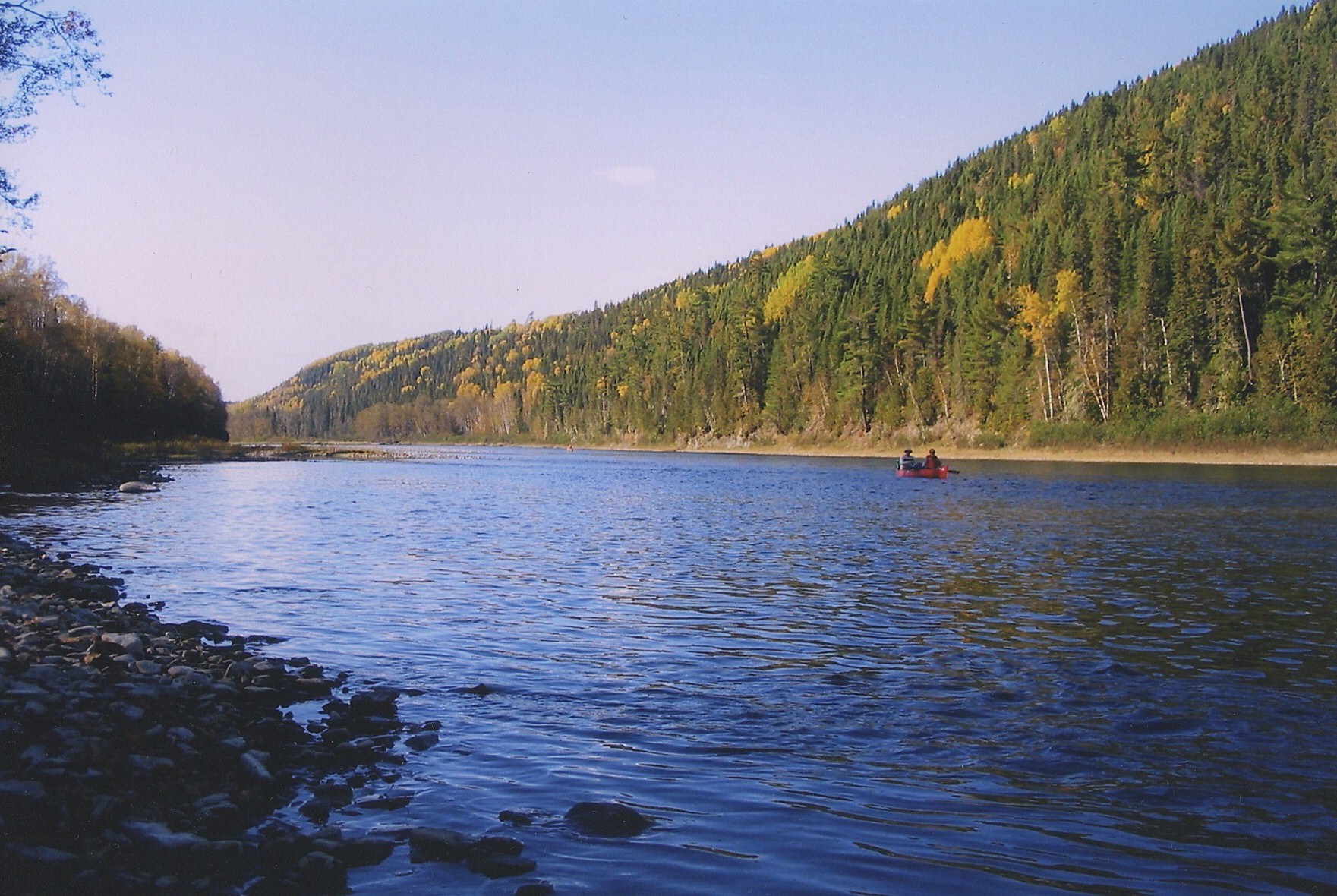
There was the possibility of meeting black bears, moose and even the elusive, but according to many real, eastern panther along the shores as they came down to drink of these pristine waters. But not today. We were content with bald eagles, broad winged hawks soaring above the increasingly steepening banks, many mergansers and the ki-ki-ki of kingfishers, not to mention the leaping salmon. Signs of man were few and far between, the most notable being the Irving family camp, which looked more like a Kennedy compound than a simple salmon camp. It was protected now by an old-timer sitting on the porch, smoking a pipe, while a boisterous English setter bid us to keep on going. He confirmed (the old-timer, not the dog) that this was the Irving camp and our destination for the night was about an hour ahead. In what seemed like no time we’re at Hafford’s pool, the first night’s destination. It was hard to believe that we had been canoeing for five hours without a break.
Hafford’s pool was a lovely spot. The river, while wide, was in a modest canyon of flaming hardwoods. The light on the river sparkled like proverbial diamonds – it was great to see that there is a reality to this cliché. Further down we could see flat water where the hills are reflected like a visual echo on the water.
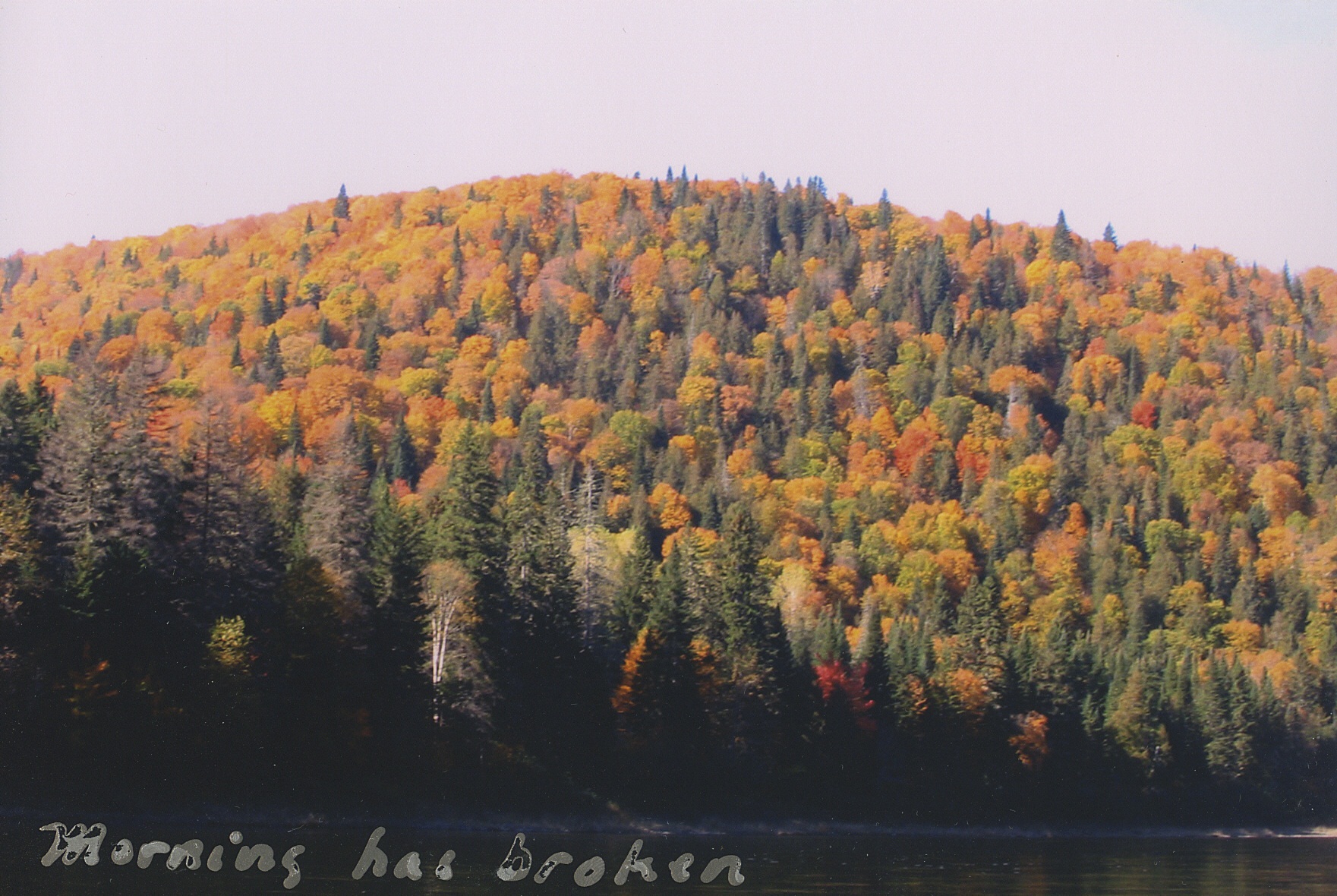
We pulled in, emptied the canoe and found a suitable spot for the tent. That meant hauling up and opening the canvas container marked “tents”. There were apparently three tents stuffed into what looked like space for one at most. After considerable physical effort and much swearing the container gave birth to one tent. We left it for other midwives to produce the other two.
I now realized why I was in such a hurry to leave before the others. Nothing can make you look more stupid than the inability to take a few pegs, some yards of canvas and a bunch of ropes and make it into a grand country residence. Luckily I had remembered to bring my reading glasses so I could just discern the hieroglyphics that passed for instructions on assembling the tent. In no time at all we had the tent up – completely inside out and backwards. It looked great to me, but Alison is picky and made us do it right; that only took another half hour.
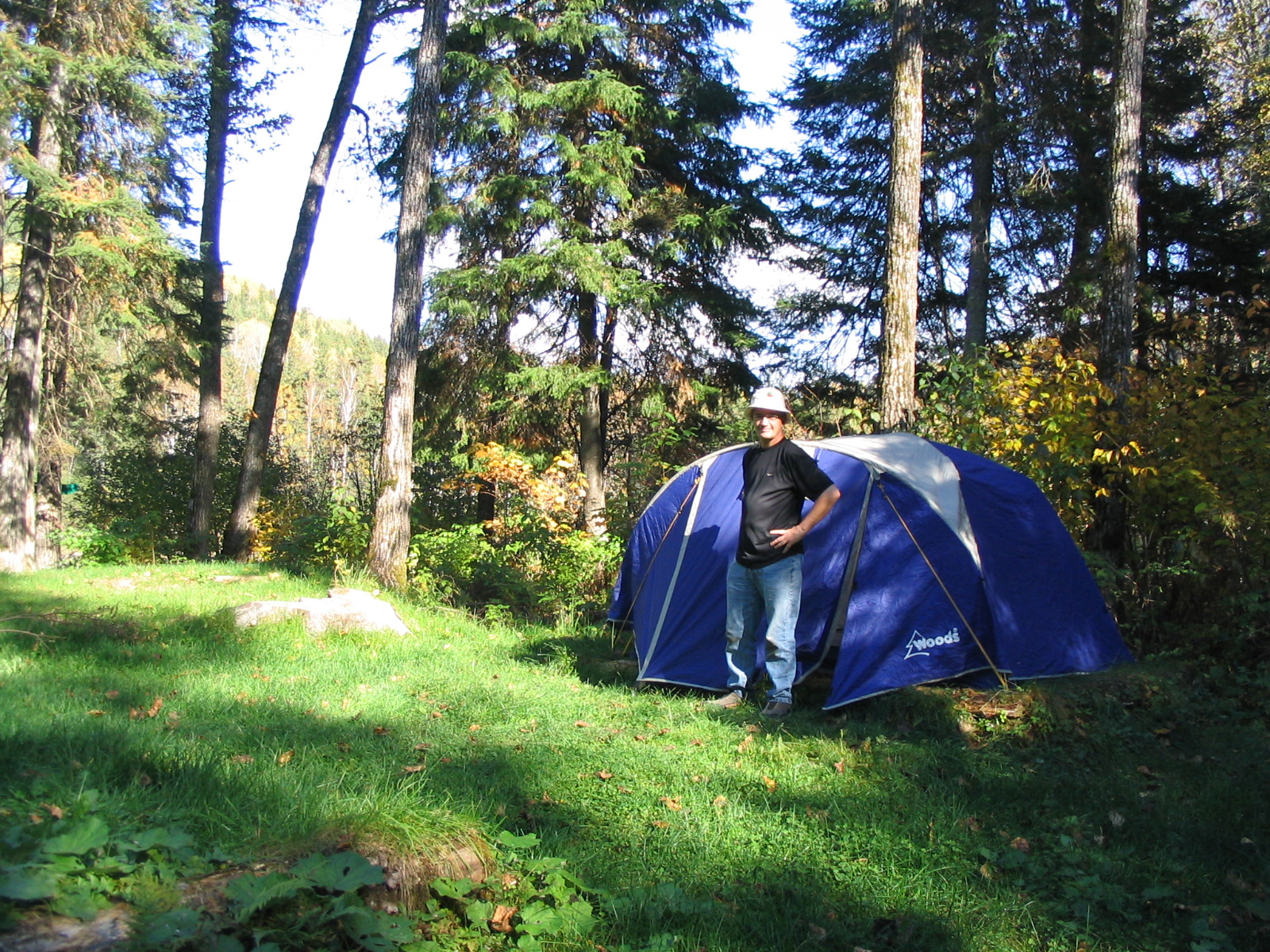
Just about this time the first of the rest appeared, laden with driftwood logs on their canoes. We helped them land and once again I learned the negative side of being here first. It was great fun lugging all that gear I had taken down to the river only six hours ago, back up the bank again.
Soon everybody had arrived safely and chosen a spot to pitch their tents. We were now recognized experts at erecting tents. It was amazing how quickly we could now identify what everybody else was doing wrong. Actually our trial and error experience proved useful as we were able to help a number of other initially baffled campers to get their tents up.
There is no need to recount the events of the first night’s supper and campfire sing-along other than to say the salmon stuffed with rice was excellent as was the company. We were well supplied with Coleman stoves and grills for placing over an open fire. Everyone pitched in and even though there was initial confusion as to who had what in their canoes, it was easily sorted out. Two of the coolers we carried contained nothing but potatoes wrapped in tinfoil ready for baking. These were a welcome sight to one of our group who would eat nothing but potatoes. Over the next five meals she ate baked potatoes, fried potatoes, refried potatoes and finally mashed-into-a- pulpy-mass potatoes.
Bedtime for most was well before midnight. We selected our campsite because it was closest to an incoming brook, so there was the steady gurgle of running water which acted like a sedative and quickly lulled to sleep. About four I was awoken by what seemed like a spotlight shining on the tent. Going outside I saw that a full moon had risen and was shining directly on the water with a brilliance that illuminated the hills. It was so bright that it actually drowned out most of the stars that were so noticeable earlier in the evening.
Returning to sleep we both arose at first light, which is usually our habit. The morning dawned cool, still and clear and there was a mist hanging over the hills that wasn’t there at four – autumn at its best. Season of mists and mellow fruitfulness as Keats penned in Ode to Autumn. We are not the first ones up. Two others were shaking out the cobwebs and before long they had the fire rekindled. We volunteered to start breakfast and in what seemed like a very short time we had mounds of fried bacon, scrambled eggs, toast and coffee for all those who were starting to emerge from their tents or hammocks.
One notable Rip van Winkle announced his continued soporific state by dint of snoring so loud that some claimed to have confused it with the roar of a bear in the night. Eventually even he came around although a few continued to enjoy the comfort of a warm sleeping bag and dry tent.
It was now about 8:30. Today’s distance was to be the longest of the three days and Alison and I, being the patient souls we are, wanted to get moving. Our gear had been packed up for a while. I had made no effort whatsoever to get the tent back inside its three tent carrying case and didn’t plan to. Shortly after stowing it in a dry sack were off again. I hoped the rest wouldn’t think we’re snobs or loners, but the Restigouche was just too alluring to linger at the campsite.
The river maintained its fast flowing character throughout most of the day although there are a few areas of flat water and many mini rapids, especially where islands split the banks. However, like yesterday there was nothing than anyone but a novice canoeist would find difficult.
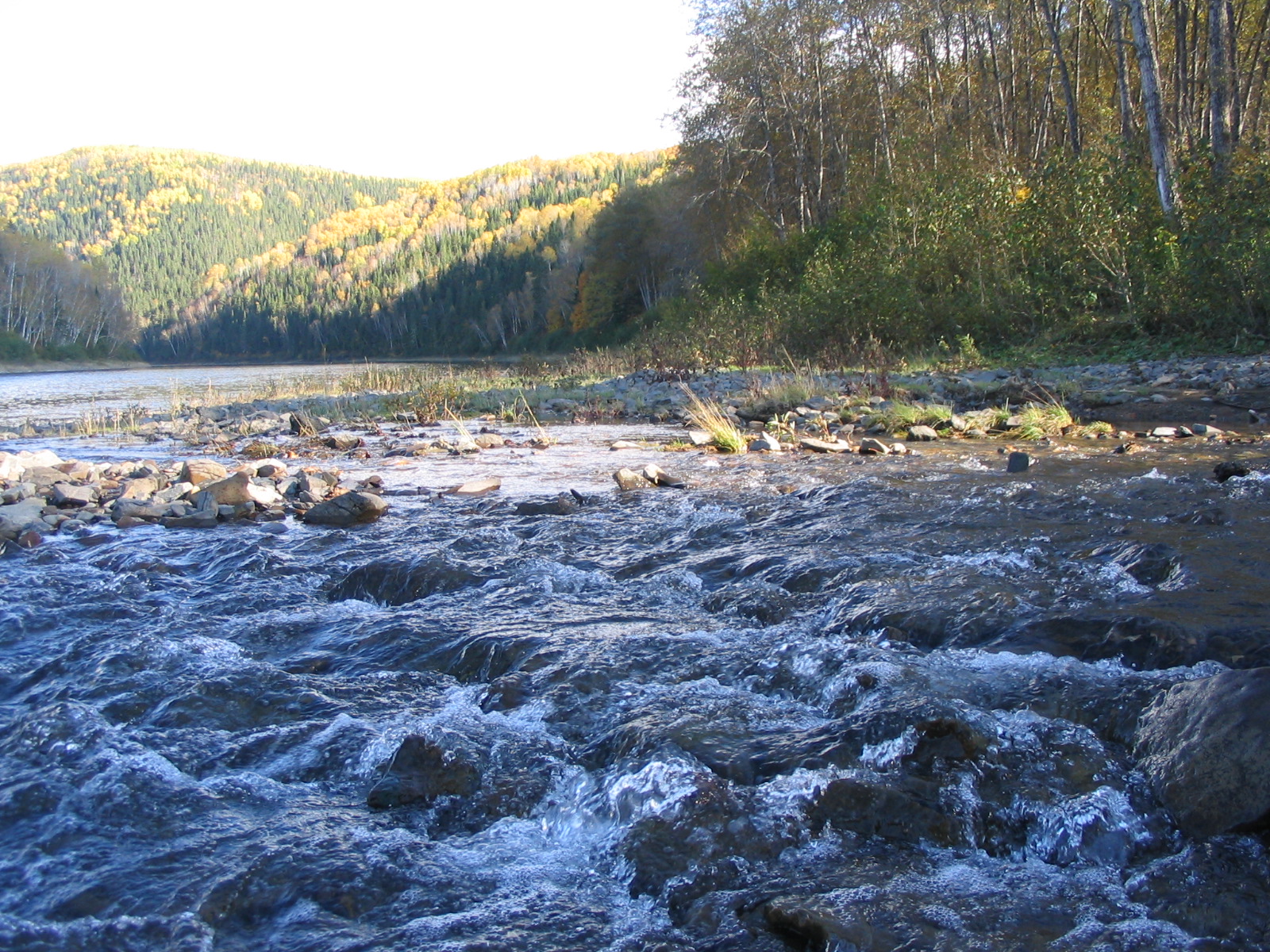
Not long after starting out we come upon a family of otters, two adults and four kits that were gambolling around a protruding log. They were completely unafraid and ignored us as we glided by thirty feet away. About halfway through the day’s journey we come to the mouth of the Patapedia where this was another large camp that bordered on the legendary Million Dollar Pool. We later learned that this camp was a favourite haunt of regulars such as Jack Nicklaus and other celebrities.
From here on the province of Quebec made up the left hand bank of the Restigouche and New Brunswick the right. Not far past the Patapedia the banks began to rise steeply and almost without noticing it we found ourselves in a true canyon – not a Grand Canyon canyon, but a sizeable one by Maritime standards. The river began to meander noticeably although it was still quite wide.
We had been alerted to look out for a cross atop a canyon ridge and told that you could hike up to it, which we planned to do. We saw the cross, actually two, well in advance but as we neared could see no sign of a path, only an extremely steep embankment which you might get up, but getting down would be another story. Consulting the map I noticed that the spot where the crosses were placed was a very narrow ridge and that the river would soon make a virtual u-turn and return us to the other side of the crosses. This did happen, but we still couldn’t see any sign of a path even after we stopped and reconnoitred the bank for a considerable way. How did they get those crosses up there in the first place if there was no path?
We did come across a great picnic site on Cross Island and stopped there for lunch. After a little exercise to relieve cramped legs, we looked once more for the elusive path and failed to find it. We concluded that it must be on the other side and we had somehow missed it. It was the one disappointment of the trip as we both enjoy a good climb and the great panoramas that usually reward for such efforts.
The weather that afternoon was phenomenal, reaching over 22 degrees Celsius with no wind and by now crystal clear blue skies. Although I wore only a very light nylon t-shirt and jeans, others I learned got by with no shirts and just shorts. Could this really be October 2nd?
From Cross Island it looked to be an easy run down to Gilmore Island where we were to camp that night and it almost was. Just before the campsite we approached what appeared to be yet another set of routine rapids, maybe a little bigger. By now I had come to enjoy taking the most direct line through the rapids (or riffles as any experienced canoeist would call them) for the thrill of having the canoe bob up and down and pick up speed. Just a little late I realized these rapids might actually be real. We did a little more than bob up and down, but made it through unscathed although Alison got a pretty good soaking. She wasn’t impressed, especially when later arrivals easily skirted the rapids by staying close to the bank. That night we learned that this spot had been the scene of several dunkings in the past.
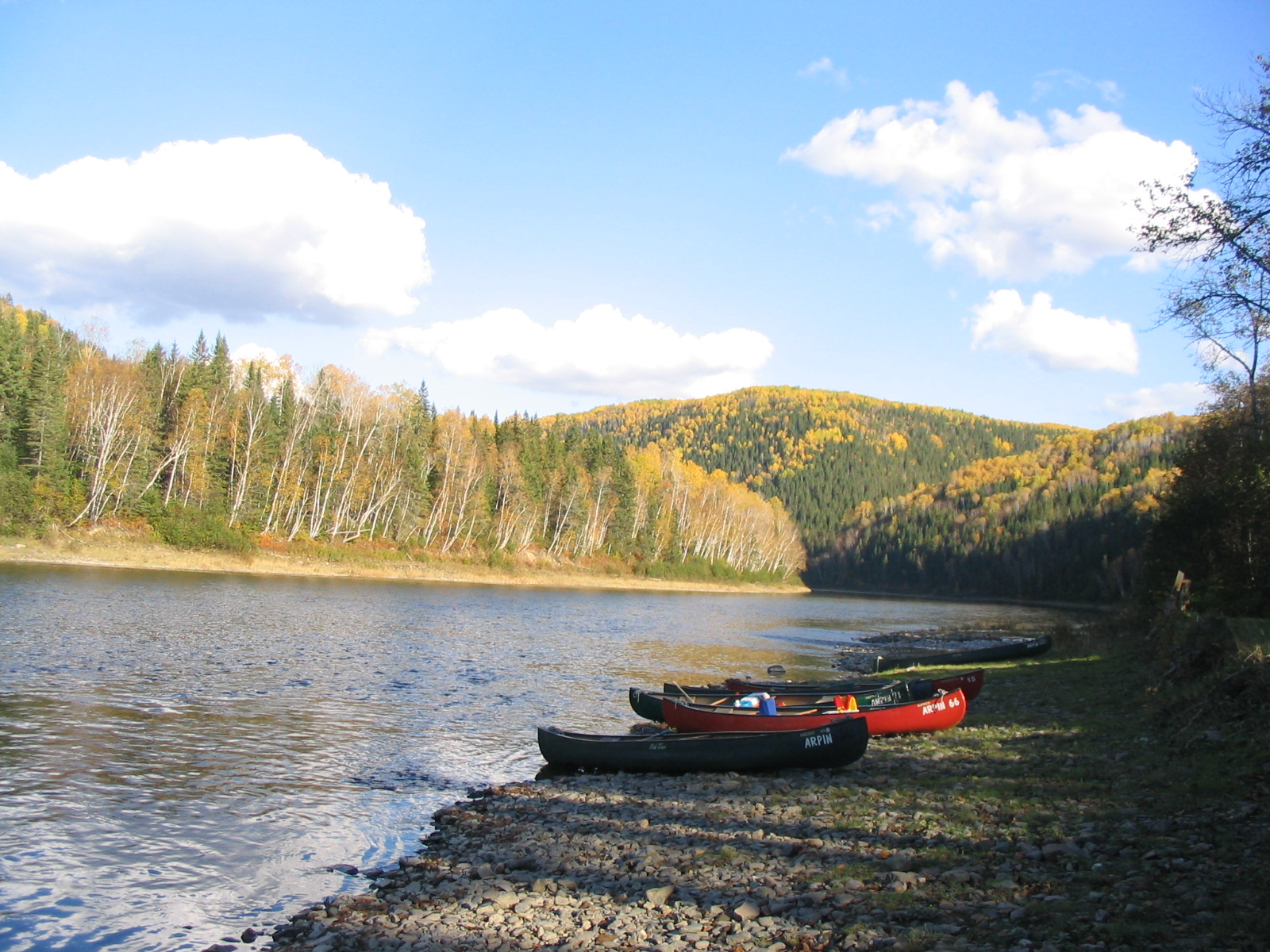
The others started arriving about an hour and a half later. Helping the others unload I quickly learned that many of them had in fact climbed up to the crosses. What I forgot to take into account was the fact that what for Alan, the group leader, might be a path, most others would confuse with a cliff. Apparently some clambered up either side clinging to whatever they could, especially on the way down. The only consolation for us was that most reported the view was disappointing and anticlimactic. Sounds a bit like sour grapes.
Tonight we were to get an unexpected appetizer from Pierre Pineau. Pierre had recently retired as a professor of education to follow has his lifelong passion of exploring the Canadian wilderness. By appearance he is the quintessential voyageur and I am told, by skills, a modern day courier du bois. Pierre magically produced herbed garlic butter, escargot and mozzarella cheese to make an appetizer equal to that served in the finest Quebec restaurants. It was all done in what seemed like no time at all. Pierre said it was an example of how well the people that he guided ate on his trips.
After supper it was time for another singsong followed by, of all things, poetry reading by firelight. Eric, another regular on these trips, carries the Oxford Book of Poetry with him most times. There was something appropriate about hearing Frost’s The Road not Taken in this environment. There were an awful lot more people back home watching TV, surfing the net or even working than the few who had chosen the path to the Restigouche this weekend.
The poetry and all else was cut short when it started to rain about midnight. The forecast called for rain and we went to our tents resigned to the fact that tomorrow would be a soggy and cold finale to the trip. I don’t know what we did to deserve it, but when dawn came it was clearer and warmer than the first two days, with not a cloud in the skies.
As we had at least a four hour paddle followed by the drive back to Halifax, most were up early. Breakfast was another hearty affair followed by striking camp and loading the canoe. Just after eight Alison and I were off. About a third of the way on the map there showed one spot marked Class II-III. I asked about this and was assured it was nothing. We made an easy descent to this point, passing a lookout post high on a bluff on the Quebec side. Apparently you can climb this from the river although it was built to be accessed from a road that ran from L’Ascencion-de-Patapedia, a tiny settlement inland from the river. This lookout was much higher than the two crosses on Cross Point and looked to give a much better panorama. Something to look forward to next time.
Approaching the spot I had inquired about I noticed a distinct narrowing of the river with what appeared to be a solid line of white entirely across it. There appeared to be no way through other than to pick a spot where the white line was a little lower than elsewhere, which is what we did. Upon nearing it was soon obvious this was the sharpest drop of the trip. We went through with no problem, but the front of the canoe did go under for a short spell and filled about half up with water, making paddling a lot more interesting. We beached as soon as we could, emptied everything out and dumped the water. It wouldn’t have been pleasant if it was cold and rainy, but it wasn’t and it didn’t cause much delay.
From here on in the signs of civilization started reappearing with cabins becoming more common as the high walls of the river gradually receded and a flood plain took its place. Before long there were farms and a few settlements. For the first time since Friday morning the sound of cars and trucks broke the silence. Salmon continued to be plentiful and the riverbed was as brightly speckled with rocks and stones of all colours as any portion yet. Around one we reached the mouth of the Upsalquitch with legendary Camp Harmony overlooking the junction. From here it was another half hour to The Landing and time to pull out.
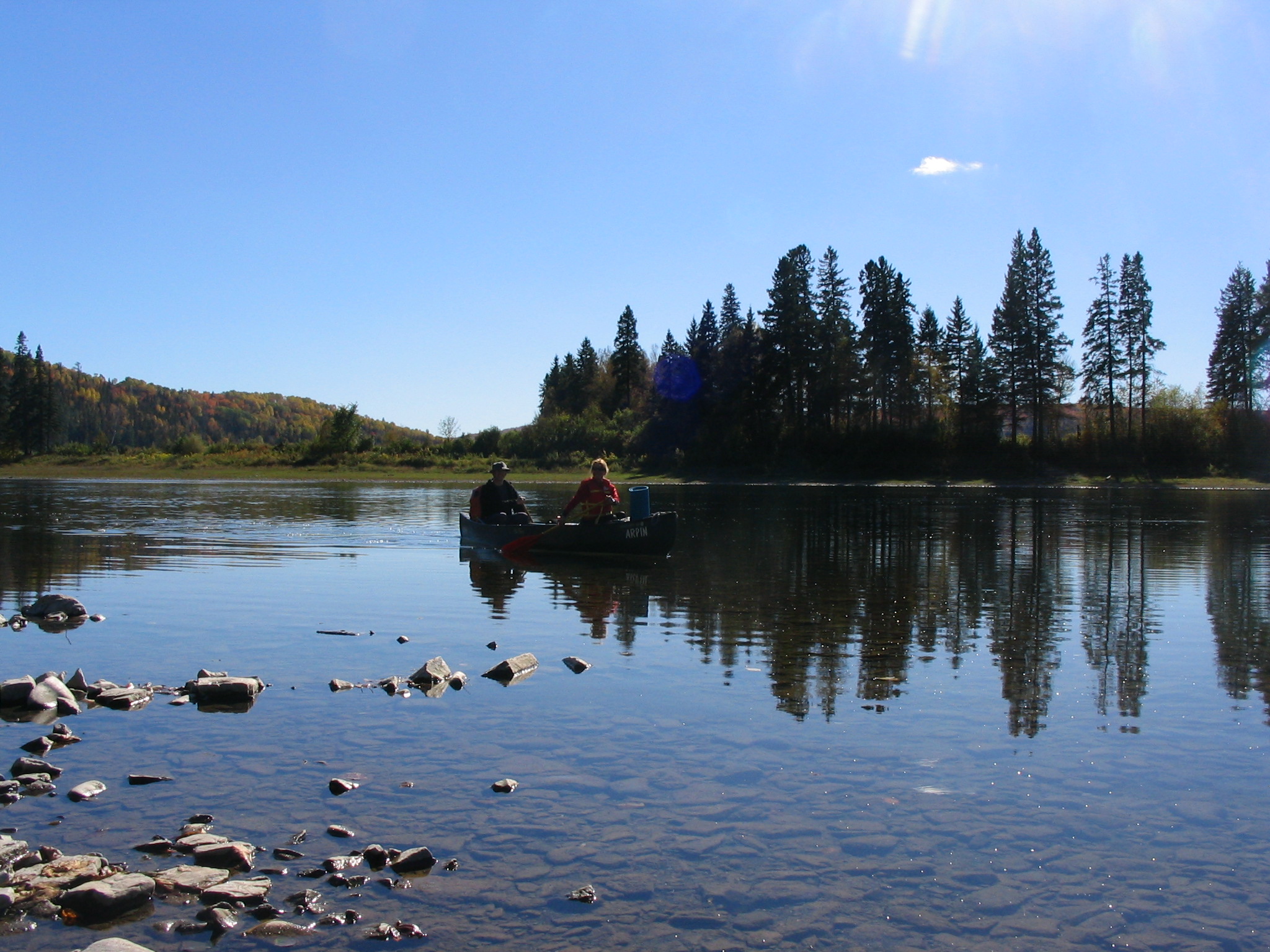
Roland was there to greet us and we were relieved to see that all of the vehicles had already been transferred. While waiting for others to arrive we had a chat with a number of locals who had come down to the river for a Sunday drive. We heard many stories of earlier times on the river. It seems everyone in the area had, at one time or another made the trip we just finished. All agreed that it is was a trip that would not be quickly forgotten, and I can attest looking back that is true.
For more adventures in a canoe check out chasing alligators in Loxahatchee National Wildlife Reserve in Florida.
UPDATE: Sadly the Arpin’s closed their business and you would need to arrange to do this tour on your own, but it is still worth it.

